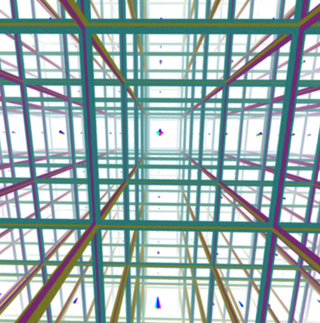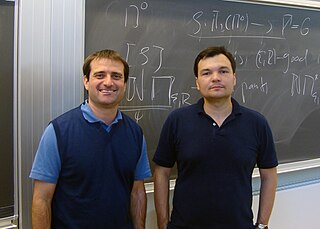
In the mathematical field of geometric topology, the Poincaré conjecture is a theorem about the characterization of the 3-sphere, which is the hypersphere that bounds the unit ball in four-dimensional space.
In mathematics, Thurston's geometrization conjecture states that each of certain three-dimensional topological spaces has a unique geometric structure that can be associated with it. It is an analogue of the uniformization theorem for two-dimensional surfaces, which states that every simply connected Riemann surface can be given one of three geometries . In three dimensions, it is not always possible to assign a single geometry to a whole topological space. Instead, the geometrization conjecture states that every closed 3-manifold can be decomposed in a canonical way into pieces that each have one of eight types of geometric structure. The conjecture was proposed by William Thurston
In mathematics, two linear operators are called isospectral or cospectral if they have the same spectrum. Roughly speaking, they are supposed to have the same sets of eigenvalues, when those are counted with multiplicity.

In mathematics, low-dimensional topology is the branch of topology that studies manifolds, or more generally topological spaces, of four or fewer dimensions. Representative topics are the structure theory of 3-manifolds and 4-manifolds, knot theory, and braid groups. This can be regarded as a part of geometric topology. It may also be used to refer to the study of topological spaces of dimension 1, though this is more typically considered part of continuum theory.

In mathematics, a 3-manifold is a topological space that locally looks like a three-dimensional Euclidean space. A 3-manifold can be thought of as a possible shape of the universe. Just as a sphere looks like a plane to a small enough observer, all 3-manifolds look like our universe does to a small enough observer. This is made more precise in the definition below.
In mathematics, more precisely in topology and differential geometry, a hyperbolic 3-manifold is a manifold of dimension 3 equipped with a hyperbolic metric, that is a Riemannian metric which has all its sectional curvatures equal to −1. It is generally required that this metric be also complete: in this case the manifold can be realised as a quotient of the 3-dimensional hyperbolic space by a discrete group of isometries.
In mathematics, a 4-manifold is a 4-dimensional topological manifold. A smooth 4-manifold is a 4-manifold with a smooth structure. In dimension four, in marked contrast with lower dimensions, topological and smooth manifolds are quite different. There exist some topological 4-manifolds which admit no smooth structure, and even if there exists a smooth structure, it need not be unique.
In the mathematical subfield of 3-manifolds, the virtually fibered conjecture, formulated by American mathematician William Thurston, states that every closed, irreducible, atoroidal 3-manifold with infinite fundamental group has a finite cover which is a surface bundle over the circle.
In mathematics, the tameness theorem states that every complete hyperbolic 3-manifold with finitely generated fundamental group is topologically tame, in other words homeomorphic to the interior of a compact 3-manifold.
In topology, an area of mathematics, the virtually Haken conjecture states that every compact, orientable, irreducible three-dimensional manifold with infinite fundamental group is virtually Haken. That is, it has a finite cover that is a Haken manifold.
Brian Hayward Bowditch is a British mathematician known for his contributions to geometry and topology, particularly in the areas of geometric group theory and low-dimensional topology. He is also known for solving the angel problem. Bowditch holds a chaired Professor appointment in Mathematics at the University of Warwick.

Vladimir Marković is a Professor of Mathematics at University of Oxford. He was previously the John D. MacArthur Professor at the California Institute of Technology (2013–2020) and Sadleirian Professor of Pure Mathematics at the University of Cambridge (2013–2014).
In mathematics, the concept of a relatively hyperbolic group is an important generalization of the geometric group theory concept of a hyperbolic group. The motivating examples of relatively hyperbolic groups are the fundamental groups of complete noncompact hyperbolic manifolds of finite volume.
In hyperbolic geometry, the ending lamination theorem, originally conjectured by William Thurston (1982), states that hyperbolic 3-manifolds with finitely generated fundamental groups are determined by their topology together with certain "end invariants", which are geodesic laminations on some surfaces in the boundary of the manifold.

In mathematics, the Ehrenpreis conjecture of Leon Ehrenpreis states that for any K greater than 1, any two closed Riemann surfaces of genus at least 2 have finite-degree covers which are K-quasiconformal: that is, the covers are arbitrarily close in the Teichmüller metric.

Jeremy Adam Kahn is an American mathematician. He works on hyperbolic geometry, Riemann surfaces and complex dynamics.
In mathematics, the curve complex is a simplicial complex C(S) associated to a finite-type surface S, which encodes the combinatorics of simple closed curves on S. The curve complex turned out to be a fundamental tool in the study of the geometry of the Teichmüller space, of mapping class groups and of Kleinian groups. It was introduced by W.J.Harvey in 1978.
Albert Marden is an American mathematician, specializing in complex analysis and hyperbolic geometry.
Chern's conjecture for affinely flat manifolds was proposed by Shiing-Shen Chern in 1955 in the field of affine geometry. As of 2018, it remains an unsolved mathematical problem.





